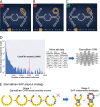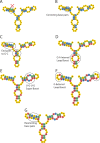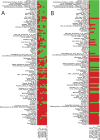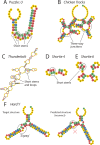EternaBrain: Automated RNA design through move sets and strategies from an Internet-scale RNA videogame
- PMID: 31247029
- PMCID: PMC6597038
- DOI: 10.1371/journal.pcbi.1007059
EternaBrain: Automated RNA design through move sets and strategies from an Internet-scale RNA videogame
Abstract
Emerging RNA-based approaches to disease detection and gene therapy require RNA sequences that fold into specific base-pairing patterns, but computational algorithms generally remain inadequate for these secondary structure design tasks. The Eterna project has crowdsourced RNA design to human video game players in the form of puzzles that reach extraordinary difficulty. Here, we demonstrate that Eterna participants' moves and strategies can be leveraged to improve automated computational RNA design. We present an eternamoves-large repository consisting of 1.8 million of player moves on 12 of the most-played Eterna puzzles as well as an eternamoves-select repository of 30,477 moves from the top 72 players on a select set of more advanced puzzles. On eternamoves-select, we present a multilayer convolutional neural network (CNN) EternaBrain that achieves test accuracies of 51% and 34% in base prediction and location prediction, respectively, suggesting that top players' moves are partially stereotyped. Pipelining this CNN's move predictions with single-action-playout (SAP) of six strategies compiled by human players solves 61 out of 100 independent puzzles in the Eterna100 benchmark. EternaBrain-SAP outperforms previously published RNA design algorithms and achieves similar or better performance than a newer generation of deep learning methods, while being largely orthogonal to these other methods. Our study provides useful lessons for future efforts to achieve human-competitive performance with automated RNA design algorithms.
Conflict of interest statement
The authors have declared that no competing interests exist.
Figures




Similar articles
-
Solving the RNA design problem with reinforcement learning.PLoS Comput Biol. 2018 Jun 21;14(6):e1006176. doi: 10.1371/journal.pcbi.1006176. eCollection 2018 Jun. PLoS Comput Biol. 2018. PMID: 29927936 Free PMC article.
-
Principles for Predicting RNA Secondary Structure Design Difficulty.J Mol Biol. 2016 Feb 27;428(5 Pt A):748-757. doi: 10.1016/j.jmb.2015.11.013. Epub 2016 Feb 17. J Mol Biol. 2016. PMID: 26902426 Free PMC article.
-
RNA design rules from a massive open laboratory.Proc Natl Acad Sci U S A. 2014 Feb 11;111(6):2122-7. doi: 10.1073/pnas.1313039111. Epub 2014 Jan 27. Proc Natl Acad Sci U S A. 2014. PMID: 24469816 Free PMC article.
-
Energy-based RNA consensus secondary structure prediction in multiple sequence alignments.Methods Mol Biol. 2014;1097:125-41. doi: 10.1007/978-1-62703-709-9_7. Methods Mol Biol. 2014. PMID: 24639158 Review.
-
Comprehensive review and assessment of computational methods for predicting RNA post-transcriptional modification sites from RNA sequences.Brief Bioinform. 2020 Sep 25;21(5):1676-1696. doi: 10.1093/bib/bbz112. Brief Bioinform. 2020. PMID: 31714956 Review.
Cited by
-
Machine Learning for RNA Design: LEARNA.Methods Mol Biol. 2025;2847:63-93. doi: 10.1007/978-1-0716-4079-1_5. Methods Mol Biol. 2025. PMID: 39312137
-
RNA Engineering for Public Health: Innovations in RNA-Based Diagnostics and Therapeutics.Annu Rev Chem Biomol Eng. 2021 Jun 7;12:263-286. doi: 10.1146/annurev-chembioeng-101420-014055. Epub 2021 Apr 26. Annu Rev Chem Biomol Eng. 2021. PMID: 33900805 Free PMC article.
-
Authorship and Citizen Science: Seven Heuristic Rules.Sci Eng Ethics. 2024 Oct 29;30(6):53. doi: 10.1007/s11948-024-00516-x. Sci Eng Ethics. 2024. PMID: 39470965 Free PMC article.
-
Fast free-energy-based neutral set size estimates for the RNA genotype-phenotype map.J R Soc Interface. 2022 Jun;19(191):20220072. doi: 10.1098/rsif.2022.0072. Epub 2022 Jun 15. J R Soc Interface. 2022. PMID: 35702868 Free PMC article.
-
RNA secondary structure prediction with convolutional neural networks.BMC Bioinformatics. 2022 Feb 2;23(1):58. doi: 10.1186/s12859-021-04540-7. BMC Bioinformatics. 2022. PMID: 35109787 Free PMC article.
References
-
- Bonnet É., Rzążewski P. & Sikora F. Designing RNA Secondary Structures is Hard. Research in Computational and Molecular Biology 248 (2017). - PubMed
Publication types
MeSH terms
Substances
Grants and funding
LinkOut - more resources
Full Text Sources
Miscellaneous

